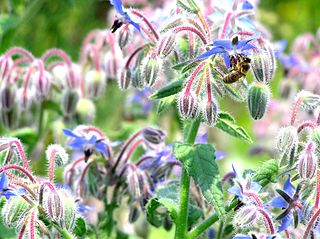
Boraginaceae, the borage or forget-me-notfamily, includes about 2,000 species of shrubs, trees, and herbs in 146 to 156 genera with a worldwide distribution.

Boswellia is a genus of trees in the order Sapindales, known for its fragrant resin. The biblical incense frankincense is an extract from the resin of the tree Boswellia sacra, and is now produced also from B. frereana.

Heliotropium is a genus of flowering plants in the heliotrope family, Heliotropiaceae. There are around 325 species in this almost cosmopolitan genus, which are commonly known as heliotropes. They are highly toxic to dogs and cats.

Boraginales is an order of flowering plants in the asterid clade. It includes the Boraginaceae and a number of other families, with a total of about 125 genera and 2,700 species. Its herbs, shrubs, trees and lianas (vines) have a worldwide distribution.

The genus of the myrrhs, Commiphora, is the most species-rich genus of flowering plants in the frankincense and myrrh family, Burseraceae. The genus contains approximately 190 species of shrubs and trees, which are distributed throughout the (sub-) tropical regions of Africa, the western Indian Ocean islands, the Arabian Peninsula, India, and South America. The genus is drought-tolerant and common throughout the xerophytic scrub, seasonally dry tropical forests, and woodlands of these regions.

Chapmannia is a genus of flowering plants in the family Fabaceae. It contains seven species with a scattered distribution – Mexico, Guatemala, Florida, and Venezuela in the Americas, and Somalia and Socotra in eastern Africa. The genus was recently assigned to the informal monophyletic Pterocarpus clade of the Dalbergieae.
Taverniera is a genus of legume in the family Fabaceae. It includes 17 species of shrubs or shrublets which range from Egypt eastwards to the Arabian Peninsula, Iraq, Iran, Pakistan, and India, and southwards to Ethiopia and Somalia. Typical habitats include seasonally-dry tropical and subtropical desert, shrubland, and bushland.
Gymnocarpos bracteatus is a species of plant in the family Caryophyllaceae. It is endemic to Yemen. Its natural habitat is subtropical or tropical dry shrubland.

Gymnocarpos is a genus of plants in the family Caryophyllaceae.
Hoplestigma is a genus of flowering plants in the family Boraginaceae, although this is disputed, and it has been placed in its own family Hoplestigmataceae. Its two species are native to Cameroon, Gabon, Ivory Coast and Liberia in western tropical Africa.

Thamnosma is a genus of flowering plants in the rue family, Rutaceae. Plants in this genus are sometimes known by the common name desertrue.
Xylocalyx is a genus of plants in the family Orobanchaceae.

Boraginoideae is a subfamily of the plant family Boraginaceae s.s, with about 42 genera. That family is defined in a much broader sense in the Angiosperm Phylogeny Group (APG) system of classification for flowering plants. The APG has not specified any subfamilial structure within Boraginaceae s.l.

Cryptolepis is a plant genus in the family Apocynaceae. It includes some 42 species.

Plocama is a genus of flowering plants in the family Rubiaceae. It was described by William Aiton in 1789. It is distributed from the Canary Islands to northwestern India.
Plocama puberula is a species of flowering plant in the family Rubiaceae. It is endemic to the Socotra archipelago of Yemen. Its natural habitat is rocky areas.
Heliotropiaceae are a cosmopolitan family of flowering plants with approximately 450 species worldwide, though it is concentrated especially in the tropics and subtropics.

Coldenia, named after C. Colden, is a monotypic genus of flowering plants traditionally included in the borage family, Boraginaceae sensu lato. It was assigned to the subfamily Ehretioideae, but molecular data revealed it to be more closely related to the genus Cordia, so that other authors placed in Cordioideae. Subsequently, it was placed in its own family, Coldeniaceae, within the Boraginales order, by the Boraginales Working Group.
Campylanthus is a genus of flowering plants belonging to the family Plantaginaceae.
Chorisochora is a genus of flowering plants belonging to the family Acanthaceae.












